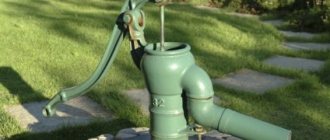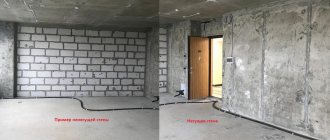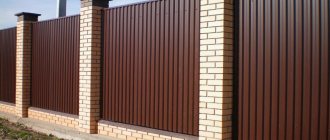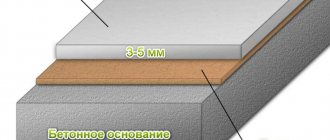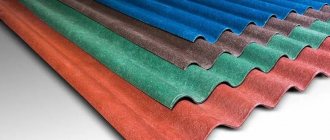In the absence of a central water supply on their plot, the owners of country houses are forced to solve the water supply issue on their own. The use of underground sources allows you to lead an autonomous existence with the maximum level of comfort. Before constructing a water intake, it is important for a private developer to have an idea of the location of aquifers, their characteristics, and search methods. In the future, this will help determine the choice of aquifer and the construction of the corresponding hydraulic structure.
What are aquifers?
The soil in the cut is very heterogeneous in composition. Its layers are arranged in horizontal layers of different thicknesses. Some of them pass water well through themselves, while others do not have this ability or have very little, so they are waterproof. Aquifers are very clearly visible when drilling water wells, and if you drill deep, you can evaluate the composition of all layers.
Soil composition in section Source shkolnik.pro
By depth
As it moves away from the surface of the earth, groundwater is divided into several types.
- Verkhovodka - at a depth of 3-5 m.
This is a very unstable layer of water, the volume of which directly depends on the time of year and the amount of precipitation. During prolonged drought or active water intake, it can dry out and is restored only due to precipitation. They seep through the ground, along the way absorbing contaminants encountered along the way. If there are industrial enterprises, large roads, cesspools, barnyards, or cemeteries nearby, then it is strictly forbidden to use perennial water for drinking purposes. The danger is further aggravated by the fact that such water is saturated with oxygen, so microorganisms actively multiply in it.
- Groundwater - at a depth of 6-8 to 40 m.
This layer lies on an aquifer in the form of clay, and water enters it both from the surface of the earth and from natural reservoirs, seeping through the soil.
Most individual wells and wells are fed by groundwater Source rusinfo.info
Sometimes it is difficult to determine the aquifer when drilling a well and not mistake the perennial water for groundwater. To do this, you need to correctly determine the depth at which the water appeared and evaluate its quality. The further from the surface, the cleaner the water is, since it is better filtered when passing through sandy horizons and contains less oxygen.
- Artesian waters - at a depth of 70 m.
Atmospheric precipitation does not penetrate into aquifers located between aquifers, so water localized at great depths and protected by an impenetrable “lid” does not contain biological contaminants, but is oversaturated with mineral elements. Artesian water, often called interstratal water, is characterized by stability and large volume, independent of season and weather conditions. These layers of water in the ground are protected by the state as natural resources, so a license is required to drill and operate an artesian well.
The water between the layers has its own pressure and can flow out of the well Source today.kg
See also: Catalog of companies that specialize in engineering systems (heating, water supply, sewerage and others) and related work
By characteristics
When planning to dig a well or drill a well, you need to find an aquifer and determine its characteristics:
- depth of occurrence - to estimate the volume of work and the amount of materials for arranging the source;
- productivity in the form of the volume of water that can be obtained per unit of time - to understand whether it is enough for your needs;
- amplitude of water fluctuations depending on the season (for groundwater).
Without such data, you can waste time and money, but not get the expected result.
Most often, water “leaves” from shallow upland wells Source vsevoda.ru
Scheme
Groundwater diagrams are drawn up by hydrogeologists. There may be several varieties of them in one limited area.
Surface waters in the diagram include the water level and soil waters. The capillary fringe and rise are water penetrating to the surface through tiny cracks in the rocks.
The diagram shows a non-pressure version with a mirror (reservoir) . In addition, 2 aquitards are shown separating groundwater and interstratal water.
How to find an aquifer
The most reliable way to search for water is to study the layers of the earth in order in the section while drilling. It also allows you to accurately determine the depth of the aquifer, its thickness and productivity.
Collection of information
There are simpler and less expensive methods than exploratory drilling.
- Study of existing sources.
If there are already residential buildings nearby with an autonomous water supply, it is enough to talk with their owners and get information about the depth of their well, its flow rate, water quality and seasonal fluctuations in its level.
- Contacting organizations involved in drilling wells in your area.
They probably have data on soil composition, aquifers and other necessary information.
- Studying the map of occurrence of aquifers.
It can be obtained upon application from Rosgeolfond, local institute of hydrology, or territorial geological information fund. Or find it on the Geological Library portal GeoKniga.
Fragment of a geological map of the Moscow region Source geokniga.org
Simple detection methods
But this all relates more to observation than to research itself. In the reserves of folk wisdom you can also find special experiments that help in finding a place for a well. Remember them, perhaps they will be useful to you.
- Remove the turf in a small area and place a piece of wool on the ground and a fresh egg on it. Cover the whole thing with an ordinary clay pot and then with turf. In the morning you need to check: if dew covers both the egg and the wool, then the water level is very close. If only the wool is wet, then there is water, but it is located at a depth of several meters. If both the wool and the egg remain dry, then the water is very deep or there is none at all.
- Mix sulfur, quicklime and copper sulfate in equal proportions, place this mixture in a clay pot and cover with a cloth. After this, place the pot in a hole at a depth of 0.5 m and cover it back with earth. But before this, it is necessary to carefully weigh the mixture being laid. After 24 hours, dig the pot back up and weigh the existing mixture again. If the mass of the mixture has increased by 10% or more, this means that groundwater is passing close. Silica gel can be used instead of a mixture of these substances. The method of using it is completely similar to the above.
- Even simple red bricks can be used as an indicator. They also need to be well dried, weighed, wrapped in cloth and buried half a meter deep. After 24 hours, they are dug up and weighed. If the mass of bricks has increased, it means that they have absorbed moisture and there is an aquifer somewhere nearby.
- The search for water using so-called dowsers is also well known. Someone may doubt this, but for a long time such people were in demand among the peasantry, especially in arid places. Numerous experiments have proven the possibility of such people searching not only for water veins, but even for minerals, deep voids and other underground anomalies.
Exploration drilling
All the methods described above are good when you are not tied to a specific place. But in most cases, there are not many points on the site where a source can be installed, since it must be within the boundaries of the site, closer to the house, away from the toilet and other “hot spots”.
In fact, water is everywhere, the only question is how deep the aquifer is. If you are not aiming for an artesian well, then you can choose the best place for a well or a sand well using a regular garden drill, which increases in length. An indicator of the proximity of water is wet coarse sand.
Selection of equipment for a well - its types and types
It all depends on the type of soil on the site, the well itself, its depth and purpose - a large amount of additional equipment can be used. Let's look at the main types and types most often used when digging wells:
- hydraulic accumulator;
- two adapters: one for removing the pipe from the bypass column, and the second for sealing, if there is no caisson;
- pump and a set of parts for its installation - used to supply water;
- non-return valve - it lets water into a house or other building;
- the pressure gauge will show the pressure level in the pipes - an important point for the general control of the entire system;
- cable made of stainless steel with the same clamps;
- a sufficient number of tees for branching the water supply network;
- consumables - fasteners, sealant, electrodes.
On our website you can buy Aquario hydraulic accumulators and get a discount on its installation.
Video description
How to determine the aquifer during hydrodrilling can be seen in this video:
But for exploratory drilling, it is better to invite specialists with professional equipment who, in the process of work, will obtain for you all the necessary information regarding:
- formation depth;
- the presence of difficult-to-pass areas - quicksand, stones, etc.;
- characteristics of all layers of the earth during drilling;
- aquifer productivity;
- water quality.
All this will allow you to determine as accurately as possible the required amount for the arrangement of the source, and decide on the need to install water treatment filters.
Natural phenomena
Additional information about the location of groundwater can be obtained by observing natural phenomena. Dense water fog accumulates above the soil, under which the underground channel passes, and midges hover. The dense vegetation has a rich color and is covered with heavy dew in the morning. In order to verify this, it is recommended to observe the area for several days.
Water carriers often reproduce the line of the landscape, which increases the likelihood of water occurring in natural pits. A rectangular hydrographic network configuration, characterized by sedimentary faults, is the best location for constructing an aquifer mine. In conditions of folded rocks, a ground source can be located at the top of a geological fold. Dense crystalline rocks contain a branching system of water channels.
Briefly about the main thing
Water underground is located in layers at different levels. Its composition, quality, and suitability for drinking depend on the depth of the aquifer. Verkhodka is considered technical water, suitable only for household needs and irrigation. Most often, drinking water is obtained from a depth of 8-40 m from a layer located on water-resistant clay. And the purest water is considered to be from artesian wells more than 70 m deep, drilled to calcareous rocks.
Ratings 0
Well development stages
After the decision to drill has been made and the parties have agreed among themselves on the work and payment, they move on to the process itself. It is important to understand that this work can last all day from early morning until late evening - it all depends on the depth of the water and the skill of the drillers.
- In addition to special tools, a large amount of brute physical force and improvised means are used here - crowbars, buckets, shovels and more.
- A hole with a diameter of at least 1 m and a depth of approximately 50-70 cm is dug on the surface of the earth. Then, in the center of the hole, digging begins with a hand drill - until it becomes difficult to pull out the earth.
- The drill column, an automatic drilling device, comes into play. It pushes the soil up, where it is promptly collected and taken to a place that does not interfere with the process. One person simply cannot cope with this work, so there are 2-3 of them in the drilling team.
- As soon as water appears (this may be the top layer of water unsuitable for domestic needs), it is immediately pumped out with a pump. This can be repeated several times until the required depth is reached.
- Pumping and filtration (if necessary) equipment is installed. This is done if the water quality does not meet the standards, but further digging is impossible. It is important that the work be completed within a day - there is a high risk of a sudden collapse of the dug well and, as a result, drilling will be repeated, but in a different place on your site.
Traditional methods
Traditional methods may only be suitable for searching for groundwater and not pressurized water resources. The latter lie too deep and are not reflected in nature with such clarity as the former. But water layers close to the surface can be detected even without test drilling and complex technologies, and no complex device is needed - all you need to do is be attentive and patient.
Moist air cools faster over a wetter area, hence you will be able to see a light mist over the area where there is moisture in the soil.
All folk methods are aimed at finding wetter places in the area where the proximity of water affects. Let's consider these search methods.
To begin with, you just need to carefully look at your site in the evening, and nature will tell you the answers to where it is best to place the well. Moist, warm air will cool faster over a wetter area, and you may see a slight haze over the area where moisture is present in the soil.
Also monitor the behavior of your pets. For example, cats like to lie in places where the soil is more moist, while dogs, on the contrary, avoid such places in every possible way. Based on this contrast of behavior, an attentive owner can approximately identify potentially suitable places for a well.
Mosquitoes can also serve as a good moisture detector. These insects like to circle in places where water comes close to the surface and give this place away with their accumulation. After all, without water their existence is impossible.
Installation of a well in sandy soil or in soil with good permeability.
Not only people, but also animals do not like nearby water layers. Therefore, if in some area there are no mouse holes or colonies of red ants, this means that the animals do not like the place to live, since nearby water floods their homes.
Observing plants will also tell the attentive eye places with high humidity. At the end of summer or during dry seasons, plants show by their appearance the presence of nearby moisture. In those areas where it comes close, the foliage of the plants is more saturated green and, in general, the plants look less depressed.
If there is a choice, it is best to build wells in places where the soil consists of sand, gravel and other loose and granular materials. In this case, the water inflow will be higher and its quality will be higher. Clay soils do not allow moisture to pass through well, and therefore the rate of filling the well will be significantly lower, as will the quality of the water, which will always be slightly cloudy.
Based on all of the above, pay attention to all the signs that nature provides for a careful look. These signs will help you correctly use the full potential of your land, with minimal costs of finance and work.

